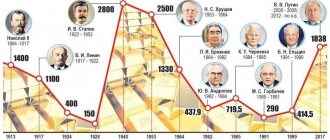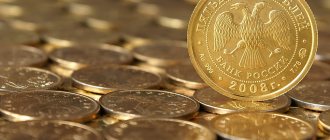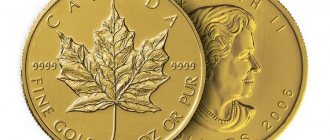The gold standard is a monetary system of the 19th and early 20th centuries in which the official currencies of countries and their paper money (banknotes) had a clearly defined price in grams (troy ounces) of gold and could be freely exchanged for it.
The exchange rate in the world in these years was determined by the ratio of the “gold backing” of each foreign currency . For example, the British pound sterling before 1914. was backed by 4.86 times the US dollar in gold. . Accordingly, all banks in the world exchanged 1 British pound sterling for $4.86 US dollars (minus the margin/spread, as the only legal income of the money changers).
Why was the gold standard for the price of money , which at first glance was so simple, fair, understandable to everyone, tested in all countries of Europe, and then throughout the world, abolished in the 20th century? This is the new material on Wiki Masterforex-V.
Finding the equivalent of money before the gold standard
The entire history of money is an attempt to find a universal equivalent to the value of the national currency of each country . In ancient times, such equivalents were animal skins, iron, salt, furs, etc., i.e. essential goods to ensure the life of primitive tribes.
With the formation of the first states, the role of money began to be played by rare earth metals - gold, silver, copper . For example,
- The Novgorod hryvnia was an oblong ingot (“stick”) weighing 204 grams
- Lithuanian hryvnia - a similar “stick” 100-105 gr. silver;
- Polish skoec - the same “silver stick” at 204 g. (as in Novgorod);
- Kiev hryvnia - a hexagon in the shape of a rhombus, weighing 163-165 grams of silver, etc.
It is not difficult to guess that the money changers of Europe had no problems exchanging this money for its silver content , as later from the 16th century, when silver and rarer gold money took on the more familiar form of coins for us.
No inflation, devaluation or revaluation of currencies in the world has occurred for centuries , unless the state itself reduced the “silver (gold) standard” of its fiat money (no, the “mints” did not succeed in cheating, although the temptation was enormous - example Copper Riots of 1662 . in Novgorod and Moscow, when Tsar Alexei Mikhailovich decided to issue copper coins at the price of silver. By the way, the money changers immediately set a “market rate” for them - 6 silver coins for 170 copper, so the tsarist government was unable to deceive the population by 2830%, although it realized this only after the blood was shed).
Attempts to deceive the silver (gold) standard also failed in Europe , when in 1661. The first paper money appeared, printed by the Bank of Sweden. Already in 1663 Swedish paper money turned out to be insolvent when they were exchanged for gold and silver, the bank went bankrupt, and paper bills disappeared from circulation.
Gold is a currency
As already stated, in a free market system, gold is the currency. It has a price, and that price will fluctuate relative to other types of exchange such as the US dollar, euro and Japanese yen. Gold can be purchased and stored, but it is not usually used directly as a method of payment. At the same time, it is in high demand and can be converted into cash, almost any currency, with relative ease.
It follows that in many respects it acts like other currencies. There are times when gold is more likely to be in high demand and times when other currencies or asset types will outperform it. Gold is supposed to benefit when confidence in fiat currencies weakens.
Investors can trade gold in several ways, including purchasing gold bullion, purchasing futures contracts, and gold ETFs. They can also participate in price movements without owning the underlying asset by purchasing a CFD.
Why was the “gold standard” introduced in Europe instead of the silver one? The role of the Latin American robbery
Gold had been used as a currency for at least the last 2,000 years alongside silver, but was a very rare metal in Europe. The earliest known mention of gold as money is recorded by historians in 600 BC. in Lydia, which is located in the western Asian part of modern Turkey.
By 560 BC. The Lydians experimentally separated gold from silver, creating the first real 980 gold coin. The popular expression “rich as Croesus” (from Herodotus’s “History”) is the best description of the immense wealth of the Lydian king Croesus, thanks to the stability of his monetary gold unit.
Over the next centuries, the value of coins from different countries was based solely on the value of the metal (gold, silver, copper) from which it was made . This was precisely the impetus for the conquest of the New World and the rise of
- first to Spain, whose navigator Christopher Columbus discovered America in 1492, in 1521. Hernan Cortes - “Aztec state” (Mexico), in 1532. Francisco Pizarro - “Inca State” (Peru), etc.
- then Portugal, the Netherlands, France and Great Britain joined the search for “new lands” and precious metals in them, and managed to become leading states in Medieval Europe due to the gold and silver captured in the colonies.
Only for 1530 The Spaniards imported about 100 tons of gold and 330 tons of silver per year into Europe , which allowed the European continent to accumulate gold reserves and gradually move from silver to the “gold standard” of backing money.
Why is this standard needed at all?
Until now, many experts believe that the gold standard makes the economy more stable. The exchange rate of money in such conditions is tied to the rate of gold, and, frankly, they play a secondary role here - everyone is interested in the precious metal, and banknotes simply allow you to exchange it at a stable rate at any time. Economists in such cases delicately call the currency “reserve”.
By the way, in addition to the gold standard, there is also the term “silver standard”.
The emergence of the “classical” gold standard
Occurred in the first half of the 19th century after the end of the Napoleonic wars. The money of most countries was presented in the form of hundreds of different types of coins made of gold, silver or copper, as well as paper banknotes issued by banks.
It was decided to tie the value of coins and banknotes to gold and introduce the gold standard in Great Britain in 1821 (although Isaac Newton, 100 years earlier, being keeper of the Royal Mint from 1699 to 1727, calculated the “fair price” of the pound sterling - £4 .24 per ounce of gold).
In 1854, Portugal switched to the gold standard , in 1871 it was adopted by Germany, and in 1873. Sweden, in 1874 France, Belgium, Switzerland and Italy, in 1892. - Austria-Hungary, in 1897. — Russia, in 1900 the USA after the start of the gold rush (from 1896 in the Klondike, from 1898 in Alaska). Thus, by 1900, almost all the leading countries of the world switched to the gold standard, because
- Gold remained a rare metal;
- To cut off from the number of leading countries in the world the majority of candidates who did not have access to large gold deposits.
Which of these two reasons was the main one, we, alas, will never know.
The gold standard lasted until 1914, when gold could be bought or sold in unlimited quantities at a fixed price in convertible paper money per unit weight of the metal.
With the outbreak of the First World War (1914), the gold standard remained only in international trade (food and weapons) , because All countries began to deplete gold and foreign exchange reserves, directing them to finance their armies, which is why paper money flooded domestic markets and began their sharp devaluation with a ban on the transfer of precious metals abroad. Thus, the Bank of England from 1914 to 1925. banned the export of gold, as well as the melting of gold coins, and the official exchange rate of the pound for gold was abolished.
Bretton Woods system
The gold exchange standard was approved at Bretton Woods, where the foundations of a new monetary system were laid. This international event took place from July 1 to July 22, 1944, and was attended by representatives of 44 states that were part of the anti-Hitler coalition (including delegates from the USA and the USSR). At the conference, decisions were made on the development of international relations in the financial and foreign exchange markets. Basic principles of the Bretton Woods monetary system (gold exchange standard):
- The American dollar was chosen as the key currency used to guide the exchange rates of other participating countries.
- The price of gold was fixed at $35 per troy ounce (31.1034768 grams).
- The central banks of the countries participating in the agreement were supposed to stabilize the exchange rate of their national currencies through currency interventions.
- Small changes in the exchange rate are allowed through revaluation (increase in the value of the currency) or devaluation (decrease in the value of the currency due to a decrease in the gold backing of the paper money supply).
- To help participating countries cover the country's balance of payments deficit and stabilize the national currency, the International Monetary Fund can issue loans and monitor compliance with the rules adopted at the conference.
The main currency that should be backed by gold was the American dollar. It was adopted as the main basis of currency parities (ratios). The dollar began to be used for international trade transactions, currency interventions, and as a reserve monetary asset. The dollar has become the world's money, replacing gold.
Gold standard in Russia
The gold standard was introduced in Russia in 1897, thanks to the monetary reform of Finance Minister Sergei Witte . The silver ruble and copper pennies were replaced by a gold ruble containing 0.774235 grams of pure gold in gold coins in denominations of 5, 7.5, 10 and 15 rubles.
The gold standard in Russia was abolished on July 29, 1914. by order of the Ministry of Finance No. 2096 (on the day the mobilization was announced). Eventually:
- all 629 million gold rubles instantly disappeared from circulation (this is 22.6% of the country's cash);
- the remaining paper bills (77.4% of cash banknotes) began to devalue, because were not freely exchanged for gold.
Photos of golden ten and five ruble notes of Tsarist Russia
What are banknotes
In fact, initially banknotes are, roughly speaking, “receipts” stating that a certain merchant left a lot of gold in a special institution and can be guaranteed to receive the same amount of gold in another branch of this institution. Why transport gold yourself along a trade route if you can hand it over in one place and receive it in another by presenting a paper receipt? Comfortable? And how!
So it turns out that the first banknotes appeared thanks to gold and were of no value without it. But what then?
How the gold standard worked
The gold standard was a strict international regulation that determined the value of a country's national currency in terms of foreign currency based on its gold content.
For example, the Russian ruble in 1897-1914. was a freely convertible currency and easily exchanged in banks in Europe, the USA and Russia
- for gold (100 rubles / 0.774235 g = 129.159 grams of pure gold);
- per American dollar (100 rubles = $51.46, because $1 = 1.50463 grams of gold;
- per pound sterling (100 rubles = 10.57 British pounds, since 1 pound cost 7.322382 grams of gold);
- for German marks (100 rubles = 216.03 marks, since 1 mark cost 0.358423 grams of gold);
- into French francs (100 rubles = 266.89 francs, since 1 French franc cost 0.290323 grams of gold).
It is not difficult to calculate the rates of other currencies of the world under the gold standard based on the indicated gold content until 1914. Central banks had to play by strict “rules of the game” and for the influx of capital they de facto had only one tool left to increase the key rate (this is how the Bank of England worked, but not the Central Bank of France or Belgium).
and food for the population were equalized around the world
- fuel and energy carriers: oil, natural gas, fuel oil, gasoline, diesel, coal, kerosene,
- industrial raw materials and metals: palladium, rubber; platinum, nickel, aluminum, copper, lead, tin, zinc, steel, cobalt, iron ore, lithium, molybdenum, brass,
- agricultural products: barley, corn, wheat, rice, soybeans, potatoes, oats, sunflowers, cotton, livestock, sugar, butter, cheese, cocoa, coffee,
Flaws
There is no financial system that does not have its shortcomings. This also applies to the gold standard, which, unfortunately, limited the maximum possibilities for economic growth by the volume of reserves of this metal held by the state. There is also a risk of significant depletion of such strategic reserves if the demand for foreign currency exceeds supply. This made states potentially vulnerable.
The crisis of the gold standard: why the world has become different forever
The triumphant march of the gold standard was short-lived and lasted fully from the 1870s until the outbreak of World War I (1914), which forced the use of unbacked paper money to finance war efforts and the introduction of restrictions on the export of gold in almost all countries. The measures taken did not help: during the 4 years of the war, the paper US dollar and British pound depreciated by 2 times, the French franc by 3 times, and the Italian lira by 4 times.
The situation was worst in defeated Germany (which began paying indemnity to the Entente countries ) and Bolshevik Russia. Both countries were gripped by hyperinflation. So,
- in Germany in 1923 inflation was 3.25 million% per month (prices doubled every 49 hours). At the denomination of November 1923 $1 was worth 4.2 trillion. old brands;
- in Bolshevik Russia during the denomination of 1924. 1 chervonets was exchanged for 500 billion Soviet rubles in 1918.
The receipt by the Entente countries of part of the indemnity from 100 thousand tons of gold reparations from Germany under the Treaty of Versailles (1918) did not solve the problems of the gold standard. The reason is the discrepancy between the amount of paper money they issued during the war and the real gold reserves in France and Great Britain, multiplied by Germany’s inability to physically pay these “reparations” (as a result, a significant part of Germany’s debts was written off and loans were issued, which began to restore the German (Weimar) economy since November 1923, i.e. 9.5 years before Hitler came to power).
The gold standard was restored in Germany (November 1924-1931), after which the United States invested an astronomical sum of $15 billion in investments (1925-1929), raising Germany's industry to second in the world after the United States itself. In response, Hitler, having received in 1933. such an industrial base was unleashed in 1939. World War 2, he tried to “knock out” the main “creditors” - Great Britain and France; it was not for nothing that the Compiègne Armistice of 1940 with France was signed in the same forest and in the same carriage as the Armistice of 1918.
In Great Britain, the gold standard began again in 1925-1931. , but the “free exchange of pounds sterling for gold” was limited only to large buyers (banks and international corporations), because was produced only for gold bars weighing 400 troy ounces (12 kg of gold). But even such restrictions did not save the stability and free convertibility of the pound. In 1931 a massive exchange of pounds for gold began. The Bank of England even took out a loan of 50 million pounds from the US Federal Reserve, but the money was only enough for 1 month. The gold standard in Great Britain was abolished.
In the USSR, the gold standard was restored in 1923, with the introduction of the gold chervonets , containing 7.74235 grams of gold (equal to 10 gold rubles of Tsarist Russia), used mainly in foreign trade operations with the “capitalist world”. The gold standard system lasted only a few years and was buried by the course of industrialization (1927) and the end of the NEP (1928).
The world economic crisis of 1929-1933 finally finished off the gold standard. , which began on October 23, 1929 with the stock market crash of all stocks and securities on the New York Stock Exchange NYSE in the USA. The world plunged into the chaos of the Great Depression, and the gold standard was officially and finally abandoned by Great Britain (1931), Canada (1931), Germany (1931), USA (1933), Italy (1934), Belgium (1935), Poland (1935) etc.
The gold standard turned out to be an unbearable burden for all the leading countries of the world .
By 1937, no country remained on the gold standard. The world was preparing for another world war, not for stable international trade.
Advantages and disadvantages
At the Paris Conference of 1821, it was established that gold would become the main type of coinage, and the gold standard was recognized in most developed countries. Thus, all national currencies were tied to pure precious metals and had a fixed exchange rate relative to each other. A deviation of no more than 1% was allowed. Naturally, this imposes restrictions: all countries adhering to the gold standard are obliged to maintain the ratio between the available precious metal and the amount of fiat money in circulation.
With the help of such a system, it was possible to achieve a fixed exchange rate, due to which trade relations received a powerful impetus for development. The external and internal economies have gained stability. The economies of states where inflation was increasing stabilized due to a reduction in gold receipts and a decrease in the amount of money issued. In the opposite situation, the opposite measures were taken. Thanks to the gold standard, it turned out to be quite easy to maintain economic stability, and experts got the chance to create a long-term and accurate forecast.
Not without its shortcomings. First of all, the disadvantage of the gold standard system was the dependence of the currency on gold mining. As soon as the pace slowed down, prices for goods fell in both the external and internal economies. There was also no possibility of developing monetary policy in the foreign market, and this had a negative impact on the provision of the military industry. Because of this, after the end of the First World War, many countries changed this system to a monetary system.
Types (stages) of the gold standard
There are three main stages in which the gold standard existed:
- gold-coin (1870-1914) - the first stage before the First World War, characterized by the fact that most money is minted from gold, and paper bills are easily exchanged for bars or coins according to the established exchange rate;
- gold bullion (1925-1931) - an attempt by Great Britain and France after the First World War to return to the gold coin standard was unsuccessful, since the gold reserves in the countries were not enough for exchange, then they decided to exchange the currency only for gold bullion, which they had the currency holders themselves do not agree;
- gold-currency (1944-1976) - a natural continuation of previous systems in the form of the Bretton Woods agreement of 1944. Read more read the main article The Bretton Woods currency system through the eyes of Masterforex-V traders
Reasons for cancellation
There were many reasons, but the main contribution was made by great upheavals in the form of the largest war in history in Europe (at that time) and the economic crisis. The gold standard, which worked well in stable circumstances with predictable developments, became a liability in troubled times.
High post-war inflation had a decisive influence on the decisions of many state leaders. The result was the abolition of the rigid peg of national currencies to gold.
Benefits of the Gold Standard System
The advantages of the gold standard were that
- in the heyday of international trade and direct investment, which gave a powerful impetus to the industrial boom throughout Europe;
- the stability of the financial system, when all governments printed exactly as much money as the country had gold reserves;
- there was no strong inflation, rising prices for goods and services, or devaluation of currencies, because there was no excessive issue of paper money,
- this prevented the formation of a budget deficit and an increase in external debt;
- this stimulated exports, since as they increased, gold and foreign exchange earnings grew;
- countries received a fixed exchange rate structure.
Advantages
One of the main advantages, of course, is ensuring the stability of exchange rates. Countries that introduced this system gave impetus to the development of international trade, the volume of which was constantly growing. Exchange rates were easily predicted, and this gave confidence in the strength of trade relationships and the ability to fulfill their obligations. Also, balance sheet deficits were almost automatically eliminated due to the free import or export of gold outside the country.
Disadvantages of the gold standard system
- The gold standard was too conservative a financial system. For example, Russia took out international loans (from France, Belgium, the USA) for the construction of the Trans-Siberian Railway and the coal regions of Donbass, although it could... finance these projects itself through the devaluation of the national currency;
- countries found themselves in unequal competitive conditions. Gold-mining states (USA, UK, Canada, Australia, Russia) received advantages, since they could always replenish their reserves with new gold production;
- The gold standard forces countries to focus on maintaining their gold reserves and ignore the more important goal of improving the business climate. Thus, during the Great Depression, the Federal Reserve, in order to prevent people from exchanging dollars for gold, raised interest rates, while it should have lowered them to stimulate the economy.
Why was gold exchanged for paper?
Gold is, of course, good, but, as it turned out, it also has its drawbacks. For example, you can cut small pieces from coins and then melt them together into something else. The gold in the cut coin will be less than “according to the declared value.” If the coins are lost, then a valuable medium of exchange will disappear from the economy (new gold coins are not easy to make). And, perhaps, the main problem is transporting coins over long distances. First of all, they are heavy. Very. Secondly, transporting gold itself is an unsafe task and, therefore, expensive.
Sergey Altyntsev, private investor, association of experts “Friend of Coins”:
— Gold is the metal of the Day of Judgment. You can use it to buy anything you want when and if the current financial system collapses due to the many accumulated problems.
Is it possible to return to the gold standard?
Really, no. The last time US President Ronald Reagan (1980-1988) convened a commission to restore the gold standard, the commission voted overwhelmingly against introducing a new gold standard. After all, just to maintain all the $2.7 trillion in cash available would require gold prices to rise to $10,000 an ounce, which would lead to massive inflation.
Many are in favor of returning to the gold standard. This will ensure fiscal discipline, balance the budget and limit government intervention, they note. Those who favor the gold standard are attracted by the simplicity of its basic rule. Others see it as an effective anchor for global price levels. Still others look back wistfully at the constancy of exchange rates.
However, a fixed money supply dependent only on gold reserves will limit economic growth . Many businesses will not be financed due to lack of capital. Moreover, the United States alone will not be able to unilaterally switch to the gold standard if other countries do not do so. If this happens, everyone in the world may demand that the United States redeem its dollars in gold. This has already happened once in history.
Gold Reserve Law
This led the Franklin D. Roosevelt administration to follow England's example by signing the Gold Reserve Act in 1934. This made it illegal for American citizens to own most types of gold, requiring them to turn over their gold coins to the Treasury at a set price of $20.67 per ounce.
This appeared to help stimulate the economy, but many argued that its long-term effects remained primarily detrimental. The final nail in the coffin of the American gold standard came in 1971, when President Richard Nixon abandoned the ability to exchange dollars for a fixed amount of gold, upending the fixed nature of international currency. Until 1971, the Bretton Woods system pegged most international currencies to the dollar, which was directly linked to gold.
This was no longer the case after 1971, and although the end of the gold standard initially stopped inflation and the rise in gold production, it had far-reaching consequences, many of which were negative.
How is the Jamaican financial system better than the gold standard?
Since 1976 The Jamaican financial system operates in the world , in which gold is only one of seven elements of filling gold and foreign exchange reserves, along with the US dollar, pound sterling, Japanese yen, euro, Swiss franc and the IMF SDR currency basket.
The Jamaican financial system is more stable than the gold standard because the price of currencies is determined in forex currency pairs in relation to each other without externally linking them to any other “standard”. Therefore, no matter how the quotes and charts of the online index change USD, EUR NZD, EUR USD, EUR AUD, GBP USD, EUR SEK, USD JPY, EUR NOK, USD CHF, GBP CHF, USD CAD, GBP AUD, NZD USD, AUD USD, GBP CAD, USD RUB, GBP NZD, EUR RUB, GBP JPY, USD UAH, RUB TJS USD BYN, USD CZK, USD SEK, PLN RUB, USD NOK, USD CNY, USD PLN, EUR CHF, EUR JPY, EUR CAD, EUR GBP, etc. this cannot cause a deep crisis and collapse of the Jamaican monetary system from within under US primacy in the world.
Read more in the main article The merits and merits of the Jamaican monetary system
What it is?
The gold standard system is an international monetary system that is based on the officially assigned gold content of each individual unit of a national currency. Central banks of states are obliged to carry out purchase and sale transactions of national currency in exchange for this metal. That is, in essence, we are talking about a fixed exchange rate of national monetary units that was established in relation to it. The terms of the gold standard implied that anyone could exchange a banknote for an appropriate amount of the precious metal at any time.
For example, the 1928 US $20 bill was equivalent to one troy ounce of gold (31.1 grams).
Thanks to the introduction of such a standard, the national currency could be freely converted into valuable metal within the country. The state could also regulate the exchange rate due to the inflow or outflow of precious metals, without limiting its export or import. This approach made national currencies very stable.
The essence of the gold standard is quite simple, but it helped solve many economic problems of the time. Unfortunately, modern realities demanded changes, and this system had to be abandoned.
Gold currency
Gold currency is a monetary unit of one of the countries of the world that can be exchanged for gold in a certain equivalent. Gold currency appeared five centuries ago and was directly related to one of the types of monetary system - the gold standard. Today, the concept of “gold currency” has remained in history, and the fact of backing monetary units with precious metal is only a formality.
One of the modern varieties is electronic gold currency. This is a form of money that is electronic and backed by a certain amount of real gold.
Introduction of hard gold currency
The oldest monetary systems were based on bronze. After this, silver appeared, which after a few centuries was replaced by another precious metal - gold. At the same time, at first (starting from the 15th century), two types of precious metals were actively used - silver and gold. It was possible to eliminate bimetallism only in the 19th century, when paper money and ordinary coins made of base metals appeared in circulation.
Gold was not chosen as a hard currency by chance. It had several main advantages over its competitors:
— unchanged shape even during long-term storage; - high price (even with low weight and volume); - unity and possibility of division; - difficulty of counterfeiting (gold can be identified by a number of characteristics - weight, color, acoustic parameters, and so on).
All this led to the fact that in many countries gold began to be used as money. But later it was decided to refuse direct appeal. There were several reasons:
— violation of the integrity of coins led to problems in monetary circulation;
- gold coins wore out quite quickly with active circulation, which led to abrasion of the metal and a decrease in its weight. As a consequence, the nominal value of the gold coin also changed, which caused a number of contradictions;
— the loss of gold coins could lead to a serious imbalance in circulation. At the same time, to restore the “gaps” the same volume of gold was needed;
— transportation of gold coins is a very labor-intensive process (especially if large volumes of capital were involved);
— if additional emission was necessary, a number of problems arose that could be caused by an acute shortage of precious metal.
Printing paper money and tying it to gold solved many problems. The precious metal was kept in one place all the time and was reliably guarded. In turn, the money played the role of a certificate, and each piece of paper was backed by a certain amount of gold. In fact, by transferring national currency to each other, people paid in gold. This was much more convenient and faster for several reasons:
— certificates (paper money) can always be restored and new ones can be issued at any time; - the monetary currency did not lose its value even with natural wear and tear; — a certificate for gold could have different denominations, which greatly simplified the process of exchange transactions.
The following dates can be distinguished in the history of gold currency:
- From 1821 to 1914, English currency could be freely converted into gold. At the same time, the pound sterling is the main reserve currency in the world;
— since 1914, the leading position has been occupied by the American currency (US dollar). The so-called dollar zone, which was located in some countries of Latin and North America, begins to form;
- in 1922 - one of the main events in the history of gold currency - the Genoa Conference, where a single gold standard and a reserve currency system were formed based on the model that worked before the war;
- In 1925, the gold standard began to operate in Great Britain. At the same time, reserves were not limited exclusively to gold - they were included in the convertible monetary unit;
— 1925 is the year of the stock market crash in the United States, which gave impetus to the powerful “Great Depression.” The economic crisis was completely overcome only after the end of World War II;
- 1931 - serious budgetary problems arose in Great Britain, which were associated with a sharp decrease in profitability due to the crisis and an increase in the level of expenses in the country. In turn, European countries began to actively “extract” their capital from the UK economy;
- In 1933, the gold standard was abolished in the United States. At the same time, a special floating rate was introduced, which made it possible to support the currency. In the same year, a powerful “golden bloc” was formed, which included a whole group of countries - Switzerland, Italy, France, Luxembourg, Belgium and Holland. The main task is the convertibility of their currencies into gold;
- in 1934, Roosevelt signed the Gold Reserve Act, which allowed the parity of the American currency to be fixed at $35 per troy ounce;
- in 1935, Belgium left the “gold bloc”, and in 1936 it completely collapsed;
- in 1936, three countries - the USA, France and Great Britain signed a tripartite agreement. They took full responsibility for normalizing the operation of the foreign exchange market;
- in 1944, the Bretton Woods Agreement was signed, according to which the “gold standard” was enshrined at the official level. From that moment on, the currencies of 44 countries were strictly tied to the US dollar. At the same time, the exchange rate of the US dollar to gold was: one troy ounce – 35 US dollars;
- the implementation of the Marshall Plan began in 1948;
— since 1948, France has joined the free exchange rate and its peg to the American currency;
— 1950 – foundation of the European Payments Union;
- 1968 - due to a sharp increase in the cost of the precious metal, the “gold pool” had to disintegrate;
- in 1971, in connection with the massive sale of US dollars, Nixon announced the suspension of the program of pegging the national currency to gold. Other reasons include the negative balance of trade and payments of the United States, as well as the discrepancy between the purchasing power of people and the real value of the currency;
— in 1975, an agreement was reached to abolish the official price of gold;
- 1976 - Jamaica Conference, after which each country gained the opportunity to establish both fixed and floating exchange rates.
At the same time, countries did not stop accumulating gold - this was one of the main priorities for achieving overall stability.
Digital (electronic) gold currency
One of the most popular forms of money, calculated in ounces of gold, is digital gold currency. Essentially, it is a type of paper money backed by gold. An example would be US certificates (money), which until 1933 could be exchanged for gold.
The unit for calculating such currency is an ounce or gram of gold. But in practice, it is known to use other units of measurement, for example, the gold dinar. The peculiarity of digital gold currency is that it is backed by real precious metal, which is hidden in vaults and reliably protected.
Today, many companies work with digital currency, which makes it possible to simplify trade turnover and transfer funds backed by gold to each other. At the same time, each of the rivals acquired its own name for the monetary unit. For example, the most popular is the one with the largest number of clients. The reason is the largest volumes of gold, which ensure all transactions between participants.
Main advantages of digital gold currency:
1. Versatility. Most users consider such money to be the most promising and universal means of payment. The peculiarity is unique stability, resistance to changes in course and various political machinations. At the same time, most precious metals have already been assigned codes according to one of the standards - ISO 4217. There are also a number of companies that work with another digital currency, which is backed not by gold, but by silver. These include eLibertyDollar, GoldMoney and others.
2. Reliability. Surprisingly, electronic gold currency is much more reliable than regular bank money. The main reason is their actual provision of gold. Supporters of such an electronic currency are confident that such capital is reliably protected from the financial crisis and the impact of such negative factors as devaluation, inflation, and other force majeure circumstances. In addition, electronic money in no way depends on the whims of the country's monetary policy. So the value of the electronic gold currency always remains the same and fixed.
3. Investments in gold. Such electronic funds, backed by precious metal, are a real investment in gold. For example, the same GoldMoney has all the necessary licenses and a certificate from the US government. Other forms of currency can be safely used to accumulate precious metals, sell them (in the form of gold currency), buy them, and so on. Moreover, GoldMoney even has its own index
4. Exchange of national currency Most companies that work with electronic gold currency do not sell money directly (for example, this happens in Liberty Reserve, e-gold, Pecunix). The transaction is made through a special digital currency exchange. The system accepts payment from many electronic systems, including through bank deposits or transfers. There are organizations that deal with the exchange of such currencies and support special cards that simplify the procedure for converting electronic gold currency into liquid form, that is, into real monetary form.
Companies that deal with such currencies do not sell them directly to customers. They are guided by only one thing - the desire to insure themselves against possible risks. Any activity related to the exchange of monetary units of different countries is inherently dangerous and carries certain risks for business. At the same time, gold currency is still in circulation (albeit indirectly) and is called “private”.
5. Irreversible operations. All providers that work with electronic gold currency exclude such wording as “negation of the transaction” in principle. This means that any transaction carried out remains valid in any case. Moreover, no changes occur even if the operation was performed incorrectly. In this aspect, electronic gold currency is somewhat similar to ordinary paper money, where the “give it and forget it” principle applies.
6. Low operating costs. The big advantage of such a system is a significant reduction in operating costs. All transactions with gold currency take place almost instantly and do not require any complex intermediary operations or additional payments. In turn, when using credit cards, checks or other standard payment methods, you have to waste time and incur additional costs.
The main risks of working with electronic gold currency. As is the case with other monetary units, gold currency has its negative features. There are four of them:
1. Currency risk. As we noted, electronic gold currency is just one form of real money. In essence, it implies a certain amount of gold in storage (custody or deposit). Moreover, in a market economy, the rates of various currencies constantly fluctuate relative to each other. Along with them, the exchange rate of gold to various currencies also changes.
Thus, each investor risks to a certain extent, as in the case of a regular foreign currency deposit. During storage, the rate of gold to the national currency may decrease and then losses will be inevitable.
It is another matter if gold currency is used for daily transactions and is not used for savings. In this case, exchange rate measurements will be practically invisible, and the risks themselves will be minimized. On the other hand, so-called fluctuations in the price of gold cannot be ruled out, which may cause some confusion among new buyers of electronic currency. But today the price of gold is more or less stable, so you shouldn’t expect too big changes.
2. Risk of management errors. The success of working with electronic gold currency largely depends on the skills and experience of the people who work with it. That is, with illiterate management, you can be left without part of your capital. Most companies that work with electronic currency have experienced many shocks and successes over the periods of their activity.
At the same time, the only company that managed to enlist the support of the US government was GoldMoney. The main problems of other structures, such as INTGold, OS-Gold, Standard Reserve, were caused by the irrational use of capital. That is, customer deposits were used not only to store gold, but also to solve their problems of capital accumulation.
As a result of unauthorized and illiterate actions of managers, many clients lost millions of dollars after the collapse of the mentioned companies. All three companies failed in the market and were forced to cease operations. This, in turn, seriously undermined people's trust in electronic currency and caused a lot of discontent among the masses.
Electronic gold currency is special in that it is not subject to any strict financial law, so there is the possibility of flexible self-regulation. In turn, companies working with such “money” are not banks in the usual sense, that is, they are not subject to any additional regulation by government bodies (that is, the state). On the other hand, gold currency is transferred from one person to another, and therefore must be controlled, subject to certain rules and fall under the jurisdiction of government agencies.
Back in 2002, the Global Digital Currency Association was formed - a powerful association that united all currency operators, users and money changers at various levels. According to management, the company’s main task is to combat online fraud, resolve disputes arising in the field of electronic gold currency exchange operations, and prevent illegal activities. At the same time, for each application it was necessary to pay one gram of gold.
3. Political risks. We must not forget that there are always political risks when working with electronic gold currency. For example, in 2007, in the United States, the Department of Justice forced about twenty million dollars in electronic currency, while part of these funds belonged to one of the providers - 1mdc. Subsequently, an attempt was made to initiate a criminal case, which failed due to lack of grounds. At the same time, after a while, the company 1mdc still had to close.
Such interference by the US government in the operation of the E-gold electronic system led to many negative consequences. A serious crisis began in the company, because many people's accounts were destroyed. But after a series of trials, the problems were resolved.
4. Risk of data loss. Gold currency is stored electronically and is entirely dependent on the reliability of storage and control of information transfer. In many ways, the security of the system depends on the computer of the account owner, as well as the provider itself. A large number of various viruses, spyware and worms aimed at stealing personal data always pose a risk of loss of capital.
In turn, each provider company approaches issues in its own way. Some take security upon themselves, create powerful anti-virus systems, and so on. Others shift the entire burden of responsibility onto the user. In this case, an authentication system is used to carry out operations, where only a login and password are required.
In recent years, security systems have become more reliable - there is additional verification by phone number, MAC address of the computer, identification via email by sending a special login password, a key system, and so on. All activities are aimed at minimizing the user’s risks when conducting financial transactions and increasing their level of reliability in the eyes of users.
In Russia, electronic gold money is also gaining popularity. Thus, the Bitcoin and Webmoney systems have become the most widespread. The first and second guarantee the provision of gold.
Gold as a currency
Without a gold standard, the price of gold fluctuates freely in the market. It is seen as a safe haven, and rising gold prices are often an indicator of underlying economic problems. It allows traders and individuals to invest in a commodity that can often partially protect them from financial shocks. As mentioned above, failures will occur with any system, even with the gold standard.
There are times when it is beneficial to own gold, but sometimes the overall trend is unclear or negative. Even though official gold standards have now disappeared, it continues to influence other currencies, so gold should be traded in the same way as other currencies.
Switching to a stronger currency could be the key to maintaining your financial health. For example, Germans who held gold-backed US dollars during the hyperinflation of Germany's Weimar Republic in the 1920s became rich rather than poor. Even when no country is on the gold standard, investors can still buy gold. By purchasing it, they exchange their local currency for the currency of many of the most successful countries in history. The Roman Empire of Marcus Aurelius, Victorian England and George Washington's America all adhered to the gold standard.
Important:
Switching to a stronger currency could be the key to maintaining your financial health.
By buying gold, people can protect themselves during times of global economic uncertainty. Ups and downs occur in any currency, this is also typical for gold. Gold is a proactive investment to hedge the potential risks of fiat currency. Once the threat materializes, the benefits of gold may already be gone. Gold is forward-looking and therefore those who trade it should also be future-oriented.











